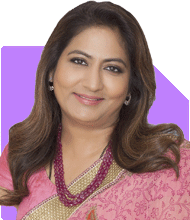Early Retiree with Rs. 3.4 Crore: How Much More Do I Need for Rs. 70,000 Monthly Income?
Ramalingam Kalirajan |7947 Answers |Ask -Follow
Mutual Funds, Financial Planning Expert - Answered on Oct 10, 2024
He has an MBA in finance from the University of Madras and is a certified financial planner.
He is the director and chief financial planner at Holistic Investment, a Chennai-based firm that offers financial planning and wealth management advice.... more

Good afternoon Sir. We are a family of 2 with monthly expenses of Rs.70K per month, max. Own house, no loan obligations. Have say 2 Cr in MF and another 1.4 Cr in other liquidity like FD. How much more funds we should have for a regular income of say Rs. 70K per month (inflation adjusted) for say next 20 or 25 years ? Please advise. Thanks.
However, when planning for the future, especially for the next 20 to 25 years, it is essential to consider inflation and lifestyle changes. Even though your current expenses are manageable, inflation will erode your purchasing power over time. Let's analyze how you can generate a sustainable inflation-adjusted income.
Estimating the Required Corpus for Retirement
Inflation is the most critical factor when planning for long-term financial goals. Assuming an average inflation rate of 6%, your Rs 70,000 monthly expense today could increase significantly in the next 20 to 25 years. For a comfortable and stress-free future, your financial plan must accommodate this rise in expenses.
Current Monthly Expenses: Rs 70,000 per month
Inflation Rate: 6% (Assumed average for long-term planning)
Retirement Time Horizon: 20 to 25 years
Investment Growth Rate: Assume your investments grow at 8% to 10% annually
Considering these factors, you would need a substantial corpus to maintain your current lifestyle without compromising on essentials or luxuries in the future.
Inflation's Impact on Monthly Expenses
Inflation steadily reduces the purchasing power of your money. For instance, after 20 years, your Rs 70,000 monthly expenses could potentially rise to Rs 2.24 lakh per month if inflation averages 6%. This is why it's essential to plan for inflation-adjusted regular income.
Projected Monthly Expenses (after 20 years): Rs 2.24 lakh per month
Projected Monthly Expenses (after 25 years): Rs 3 lakh per month
Now, to ensure that your wealth generates enough income to cover these future expenses, we need to evaluate your current corpus and potential growth.
Building the Right Corpus for Inflation-Adjusted Income
Your existing Rs 2 crore in mutual funds and Rs 1.4 crore in fixed deposits are valuable resources. But to generate Rs 70,000 per month, inflation-adjusted, for the next 20 to 25 years, a more substantial corpus may be required.
Let’s assume the following:
Sustainable Withdrawal Rate: A safe withdrawal rate is typically 4% to 5%. This rate ensures you don’t deplete your corpus too soon, even with inflation adjustments.
Given your current expenses, you would need a larger corpus to meet rising expenses and avoid shortfalls.
Evaluating Existing Investments
Mutual Funds
Your Rs 2 crore investment in mutual funds is excellent, but it's crucial to ensure you're invested in the right mix of equity and debt. Equity can outpace inflation but comes with volatility. Debt funds provide stability but lower returns. Since your goal is long-term wealth generation with inflation-adjusted income, a balanced portfolio between equity and debt is ideal.
Equity Allocation: Focus on diversified, actively managed equity funds. These funds generally outperform passive index funds in the long run, especially when market conditions fluctuate. Actively managed funds can navigate market ups and downs more efficiently, giving you an edge.
Debt Allocation: Debt funds, especially those with low to moderate risk, can provide steady returns. While returns are typically lower than equity, they provide security and stability to your portfolio.
Avoid direct mutual fund investing as it may expose you to unnecessary risk. Regular funds managed through a Certified Financial Planner (CFP) offer better advice and tailored guidance.
Fixed Deposits (FDs)
Your Rs 1.4 crore in fixed deposits is a significant amount. However, FDs generally offer lower returns compared to mutual funds and may not be sufficient to outpace inflation. Over time, your FD returns could fail to match rising costs, leading to a gap in income. You may want to shift a portion of your FD corpus into more growth-oriented instruments like mutual funds to ensure your wealth grows at a faster pace.
Creating a Balanced Portfolio for Future Needs
To generate a sustainable income, a proper mix of investments that balance growth and security is necessary. Here’s a potential strategy for building a portfolio that serves your long-term goals:
Equity Mutual Funds: Approximately 50% to 60% of your corpus should be in equity funds to grow your wealth. Actively managed funds can potentially deliver higher returns compared to passive index funds. Actively managed funds have professional fund managers who can make better decisions during market volatility.
Debt Mutual Funds: Around 30% to 40% should be allocated to debt mutual funds. Debt funds, while offering lower returns than equities, provide stability and are less risky.
Liquid Funds for Short-Term Needs: It's essential to keep some liquid assets for emergencies. Liquid mutual funds can serve this purpose, as they offer relatively better returns than savings accounts or FDs and can be quickly converted into cash when needed.
Tax Efficiency Considerations
Taxation is another critical factor when planning your finances. The new capital gains tax rules for mutual funds make it essential to choose your investments wisely:
Equity Mutual Funds: Long-term capital gains (LTCG) above Rs 1.25 lakh are taxed at 12.5%. This could impact your net returns, so keep this in mind when planning withdrawals.
Debt Mutual Funds: Gains are taxed as per your income tax slab, making them less tax-efficient than equity funds. However, their stability can compensate for this in your overall portfolio.
Structuring your withdrawals and investments to minimize tax liabilities is essential for long-term financial health.
Income Generation Strategy: Withdrawal Plan
To ensure you have a consistent, inflation-adjusted income for 20 to 25 years, follow a systematic withdrawal plan:
SWP (Systematic Withdrawal Plan): You can set up an SWP from your mutual funds to receive a regular income. This method ensures that your principal continues to grow, while you withdraw only a portion of the gains. By keeping the withdrawal rate around 4%, you can sustain your income for many years.
Rebalance Annually: As your portfolio grows or market conditions change, regularly review and rebalance your investments. This strategy will keep your portfolio aligned with your risk tolerance and goals.
Safeguarding Against Future Risks
To ensure your income remains stable for the next two decades, consider the following safeguards:
Health Insurance: Medical expenses can rise dramatically as you age. Ensure that you have comprehensive health insurance that covers major treatments and hospitalization.
Life Insurance: If you don’t already have a life insurance policy, consider one that can cover your spouse or any other dependents. Since you’re primarily focusing on wealth creation, life insurance should act as a safety net rather than an investment tool.
Final Insights
To generate Rs 70,000 per month for the next 20 to 25 years, accounting for inflation, your current investments will need to grow and be strategically allocated. While you have a solid base of Rs 3.4 crore, inflation could push future monthly expenses up significantly.
Adjust your investment mix to ensure both growth and stability.
Shift a portion of your FDs into more productive assets like mutual funds.
Use systematic withdrawal plans to ensure a steady income without depleting your principal.
Continuously assess your portfolio to stay aligned with your goals.
With the right financial planning, you can comfortably generate the income you need for the long term.
Best Regards,
K. Ramalingam, MBA, CFP
Chief Financial Planner,
www.holisticinvestment.in
https://www.youtube.com/@HolisticInvestment
You may like to see similar questions and answers below
Ramalingam Kalirajan |7947 Answers |Ask -Follow
Mutual Funds, Financial Planning Expert - Answered on Apr 12, 2024
Ramalingam Kalirajan |7947 Answers |Ask -Follow
Mutual Funds, Financial Planning Expert - Answered on May 06, 2024
Milind Vadjikar |1006 Answers |Ask -Follow
Insurance, Stocks, MF, PF Expert - Answered on Feb 12, 2025
Milind Vadjikar |1006 Answers |Ask -Follow
Insurance, Stocks, MF, PF Expert - Answered on Feb 12, 2025
Milind Vadjikar |1006 Answers |Ask -Follow
Insurance, Stocks, MF, PF Expert - Answered on Feb 12, 2025
Milind Vadjikar |1006 Answers |Ask -Follow
Insurance, Stocks, MF, PF Expert - Answered on Feb 12, 2025
Milind Vadjikar |1006 Answers |Ask -Follow
Insurance, Stocks, MF, PF Expert - Answered on Feb 12, 2025
Dr Nandita Palshetkar |54 Answers |Ask -Follow
Gynaecologist, IVF expert - Answered on Feb 12, 2025
Dr Nandita Palshetkar |54 Answers |Ask -Follow
Gynaecologist, IVF expert - Answered on Feb 12, 2025
Ramalingam Kalirajan |7947 Answers |Ask -Follow
Mutual Funds, Financial Planning Expert - Answered on Feb 12, 2025
Ramalingam Kalirajan |7947 Answers |Ask -Follow
Mutual Funds, Financial Planning Expert - Answered on Feb 12, 2025
Ramalingam Kalirajan |7947 Answers |Ask -Follow
Mutual Funds, Financial Planning Expert - Answered on Feb 12, 2025









.jpg)







